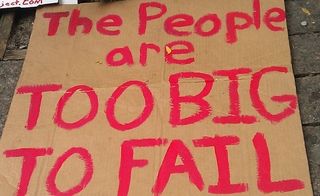We Are the 99%: Models of Public Opinion that Explain the Occupy Wall Street Movement

— Guest post by Luis Hestres, American University doctoral student.
Ever since the financial crisis hit the U.S. in late 2008, many political commentators (mostly on the Left) have wondered why public opinion hadn’t mobilized behind Wall Street reform in the U.S. as strongly and visibly as in other nations. The Occupy Wall Street movement seems like the embodiment of the sort of reaction to the crisis these observers thought missing, but still—why the delay?
A communication-centered explanation of the difficulty to reform Wall Street so far would depend largely on which view of public opinion and the nature of the public sphere (indeed, which view of democracy) you adopt. University of Pennsylvania Provost and communication researcher Vincent Price (2008) usefully describes four models of the public sphere that could potentially apply to the U.S. at various points in the debate over financial reform and other issues:
The Competitive Elitism model: Under this model, the participation of citizens is limited to expressing their opinion through the ballot box. Otherwise, public opinion and decision-making is left to policy-makers, bureaucrats, experts and other elites. Public opinion becomes a matter of elites trying to convince each other of the rightness of their policy positions. As Walter Lippmann (1922) argued, the role of experts under this model is to explain complex issues to decision-makers and to manufacture consent from the public.
The Neo-pluralist model: This model emphasizes the role of intermediary interest groups such as labor unions and advocacy groups, as well as “issue publics”—smaller segments of the population that have a much higher level of interest and policy expertise on particular issues. These “issue publics” guide the opinions of others when these issues are debated, thus creating a “division of labor” among the population that keeps decision-making relatively anchored to popular wishes.
The Participatory model: This model emphasizes vigorous citizen participation, discussion and engagement in the public sphere. Drawing heavily from Jürgen Habermas’ work on the notion of the public sphere, this model argues that mass media and public opinion polls lull the citizenry into treating politics as a spectator sport, and that the antidote lies in providing spaces for citizens to discuss public issues, come to consensus through those discussions, and to express their preferences in a manner that has weight in policy decisions.
The Legal/neoliberal model: This view amounts to a form of libertarianism that sees state efforts to alleviate social inequalities as inevitably coercive and likely to curtail individual liberty. To varying degrees, this view has become widespread in the U.S., as evidenced by the wave of financial deregulation we have experienced for the past 30 years and in other more subtle ways too, such as the frequent use of the “marketplace of ideas” metaphor to describe public debate.
Public opinion as reason versus social control. Another view of public opinion that can inform the Wall Street reform debate is Elisabeth Noelle-Neuman’s (1995) comparison of public opinion as rationality vs. public opinion as social control. Noelle-Neuman argues that public opinion is not best understood as the conscious acquisition of knowledge through reason and the advancement of rationally sound judgments (except perhaps among elites). Rather, she argues that public opinion is best understood as a coercive phenomenon that promotes social integration and insures that there is a sufficient level of consensus on which actions and decisions may be based.
Some combination of these models affords us the best chance to understand the failure to reform Wall Street to date, as well as the current potential to do so. Until the financial crisis hit in 2008, the issue public dedicated to financial reform was relatively small, leaving the public opinion field open for a competitive elitism model to play out relatively unencumbered by countervailing pressures. In this climate, a neoliberal view (sometimes called the “Washington Consensus”) became the “common sense” position, creating something akin to Noelle-Neuman’s “spiral of silence” in which to voice opposing viewpoints risked social and political alienation, especially among elites.
The financial crisis, however, has opened a space for other models of public opinion to operate as pathways to political change. As evidenced by the passage of President Obama’s financial reform bill and the “Occupy Wall Street” movement, the financial reform issue public increased in size. The Washington Consensus forged during the 90’s under a competitive elitism model is on the defensive—indeed, the whole notion of elite expertise is reeling. We are seeing a confluence between what public opinion polls (the traditional measure of “rational” public opinion) say about where the public stands on financial reform, and expressions by the issue public in the form of political protest.
In short, Noelle-Neuman’s conceptualization of public opinion as a coercive force is beginning to spiral in the other direction: unlike during the 90’s and early 2000’s, to voice support for a neo-liberal, hands-off approach to public affairs carries increasing risk of political and social alienation. The lag between the onset of the crisis in 2008 and the emergence of Occupy Wall Street today may be due to Barack Obama’s election, which delayed more overt expressions of public outrage for a while, but the gap between America and the rest of the world in that regard seems to be narrowing considerably.
As the economist Jeffrey Sach’s argues in his recent book “The Price of Civilization,” Obama might be more accurately seen as a transitional president rather than a transformational one.
It may be that during the comparatively good economic times of the 80’s and 90’s, models of public opinion that required little from the public more accurately applied to decision-making on financial reform and regulation, but because of the economic crisis, models that emphasize public involvement and the coercive force of public opinion are now more applicable. This change in how public opinion translates into social change and governance may afford advocates of financial reform an opening they otherwise would not have had. The Occupy Wall Street movement is the most visible indication to date of their determination to take advantage of this opening.
–Luis Hestres is a Doctoral student at American University’s School of Communication. Before joining SOC’s PhD program, Luis worked as an online organizer at various nonprofits and was most recently the Internet and Communications Manager at the 1Sky climate campaign. Luis holds an MA in Communication, Culture and Technology and an MFA in Film and Media Arts.
Read other posts by AU doctoral students and find out more about the doctoral program in Communication at American University.
References
Lippmann, W. (1922). Public Opinion. New York: Macmillan.
Noelle-Neumann, E. (1995). Public opinion and Rationality. In T. L. Glasser & C. T. Salmon (Eds.), Public Opinion and the Communication of Consent (pp. 33–54). New York: Guilford Press.
Price, V. (2008). The Public and Public Opinion in Political Theories. In W. Donsbach & M. Traugott (Eds.), Sage Handbook of Public Opinion Research. Newbury Park, CA: Sage Publications.
See Also:
Join Doctoral Students In Examining the Intersections Among Media, Technology and Democracy
Internet Politics Scholars Join School of Communication at American University





